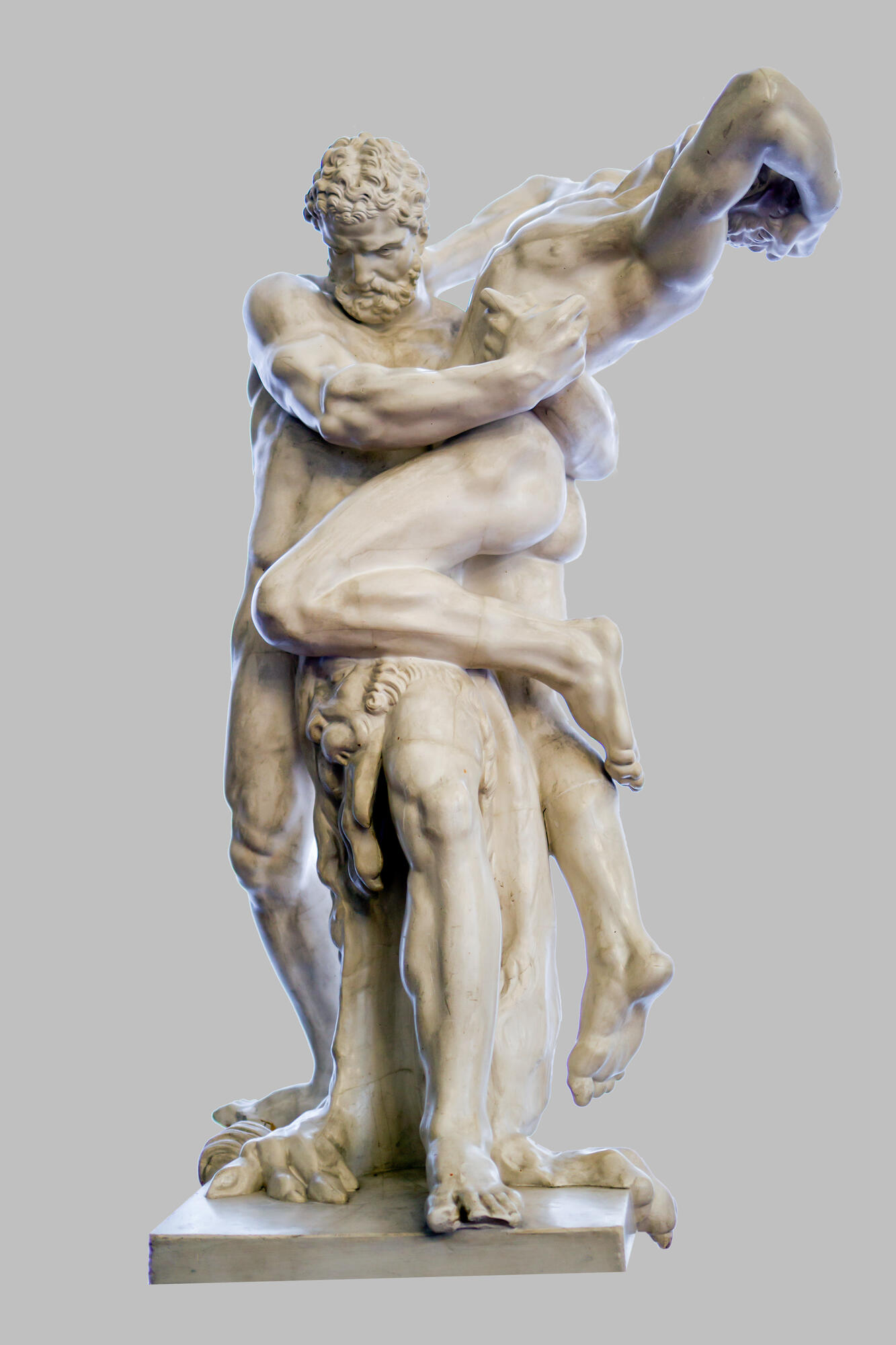In ancient Greek mythology, Antaeus was an invincible giant, the son of the sea god Poseidon and the Earth goddess Gaea. His name translates as “opponent.” The strength of Antaeus was infinite because he renewed it from his mother, earth, each time he touched the ground. Antaeus challenged all passers-by to wrestle with him and used their skulls to build a temple to his father. Heracles unraveled the secret of Antaeus and deprived him of his strength. Heracles lifted the giant up from Earth, then broke his ribs and crushed him.
The sculpture “Hercules and Antaeus” was made by Stepan Pimenov for the building of the Mining Institute in Saint Petersburg in 1811. The statue symbolizes mankind gaining power over the forces of nature: Heracles personifies the humans, and Antaeus stands for nature, the Earth and its treasures.
The other interpretation speaks to patriotism — the sculpture is believed to illustrate the military conflict between the Russian Empire and France, which began in the year when the sculpture was created and preceded the Patriotic War of 1812. Thus, this sculpture combines both the plot of the ancient Greek myth and the images that were relevant for the artist’s contemporaries.
In his sculpture, Stepan Pimenov skillfully rendered the figures of the wrestling heroes, the grandeur and drama of the fight. Being held aloft, Antaeus is doomed — this is the moment of greatest tension. One hundred years later, Vasily Kuznetsov created a smaller bronze cast of this sculpture. During that process, several plaster models were made — one of them is housed in the Ulyanovsk Regional Art Museum.
Vasily Vasilyevich Kuznetsov was the leading artist of monumental and decorative sculpture at the turn of the 20th century. He graduated from the Imperial Academy of Arts. During World War I, Vasily Kuznetsov changed his profession and became the head of the sculptural department at the Imperial Porcelain Factory. He designed classical vases, clocks, figurines and small ornamented boxes and continued using traditional production techniques.
Stepan Stepanovich Pimenov was one of the main sculptors at the beginning of the 19th century. He was a professor at the Academy of Arts, and created the magnificent chariot of Glory on the arch of the General Staff Building on the Palace Square, Apollo’s chariot on the Alexandrinsky Theater, the statues of the Kazan Cathedral and a number of other historical monuments of Saint Petersburg.
The sculpture “Hercules and Antaeus” was made by Stepan Pimenov for the building of the Mining Institute in Saint Petersburg in 1811. The statue symbolizes mankind gaining power over the forces of nature: Heracles personifies the humans, and Antaeus stands for nature, the Earth and its treasures.
The other interpretation speaks to patriotism — the sculpture is believed to illustrate the military conflict between the Russian Empire and France, which began in the year when the sculpture was created and preceded the Patriotic War of 1812. Thus, this sculpture combines both the plot of the ancient Greek myth and the images that were relevant for the artist’s contemporaries.
In his sculpture, Stepan Pimenov skillfully rendered the figures of the wrestling heroes, the grandeur and drama of the fight. Being held aloft, Antaeus is doomed — this is the moment of greatest tension. One hundred years later, Vasily Kuznetsov created a smaller bronze cast of this sculpture. During that process, several plaster models were made — one of them is housed in the Ulyanovsk Regional Art Museum.
Vasily Vasilyevich Kuznetsov was the leading artist of monumental and decorative sculpture at the turn of the 20th century. He graduated from the Imperial Academy of Arts. During World War I, Vasily Kuznetsov changed his profession and became the head of the sculptural department at the Imperial Porcelain Factory. He designed classical vases, clocks, figurines and small ornamented boxes and continued using traditional production techniques.
Stepan Stepanovich Pimenov was one of the main sculptors at the beginning of the 19th century. He was a professor at the Academy of Arts, and created the magnificent chariot of Glory on the arch of the General Staff Building on the Palace Square, Apollo’s chariot on the Alexandrinsky Theater, the statues of the Kazan Cathedral and a number of other historical monuments of Saint Petersburg.





